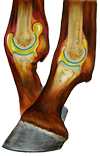Degenerative joint disease in horses
Degenerative joint disease (DJD), often referred to as “osteoarthritis”, is a very common cause of lameness in competition horses. Most strategies in equine training involve the prevention and / or maintenance of some joint disease. Lack of performance as a result of joint disease often precedes lameness and / or radiographic changes.
What structures form a synovial joint?
Bone surfaces (called subchondral bone)
Cartilage layer (covering the subchondral bone)
Fibrous joint capsule
Membrane and synovial fluid
Associated support ligaments

The combination of a cartilage surface and thick synovial fluid provides a low friction environment through which the articulation surfaces can move freely and independently of one another.
What makes synovial fluid so thick and slippery?
Within the membrane and synovial fluid there is a large molecule called hyaluronic acid which is the main component of the synovial fluid that gives it its characteristics of slippery thickness and appearance. Minimizes friction, fundamental for normal joint function, the presence of normal hyaluronic ac within a joint is very important.
The lack of hyaluronic ac in synovial fluid increases the friction associated with synovial joint surfaces, therefore predisposes to excessive cartilage wear and erosion.
What causes joint inflammation (arthritis)
It is a consequence of a joint injury and / or instability. Instability may occur as a result of a compromise of joint support structures (eg, collateral ligaments), loss of articular cartilage (as may occur in osteochondrosis), over training, or increased age.

What causes joint pain?
Most nerve endings are found inside the fibrous capsule and supporting ligaments of the joint. There is very little sensitivity in the cartilage and synovial membrane.
The three main causes of joint pain, therefore, are as follows:
Joint effusion (ie, increased fluid within the joint) resulting in distension / “stretching” of the joint capsule,
Fibrosis / healing of the joint capsule (often referred to as “capsulitis”), and
Inflammation in the associated supporting ligaments of the joint (called “desmitis”)
Therefore eliminate excess synovial fluid, inflammation inside the fibrous capsule and inflammation of the ligaments that support it will normally produce a comfortable joint.
How is degenerative joint disease (DJ) produced?
The degenerative cycle begins as a result of instability and / or joint damage.
Inflammatory cells inside the synovial and fluid membrane do two things:
Increased hydrostatic pressure within the joint releases catabolic enzymes and other chemical mediators in the joint.
The results of hydrostatic pressure in the increase of fluid inflow in the joint, distension of the joint capsule and pain. Enzymes released by inflammatory cells degrade hyaluronic acid as well as the cartilage layer.
Interestingly, the presence of pain also accentuates the activity / release of harmful chemical mediators in the joint. Increased instability of the joint, persistence of chemical mediators within the joint, and this resulting in an increased inflammatory reaction.









No Comments